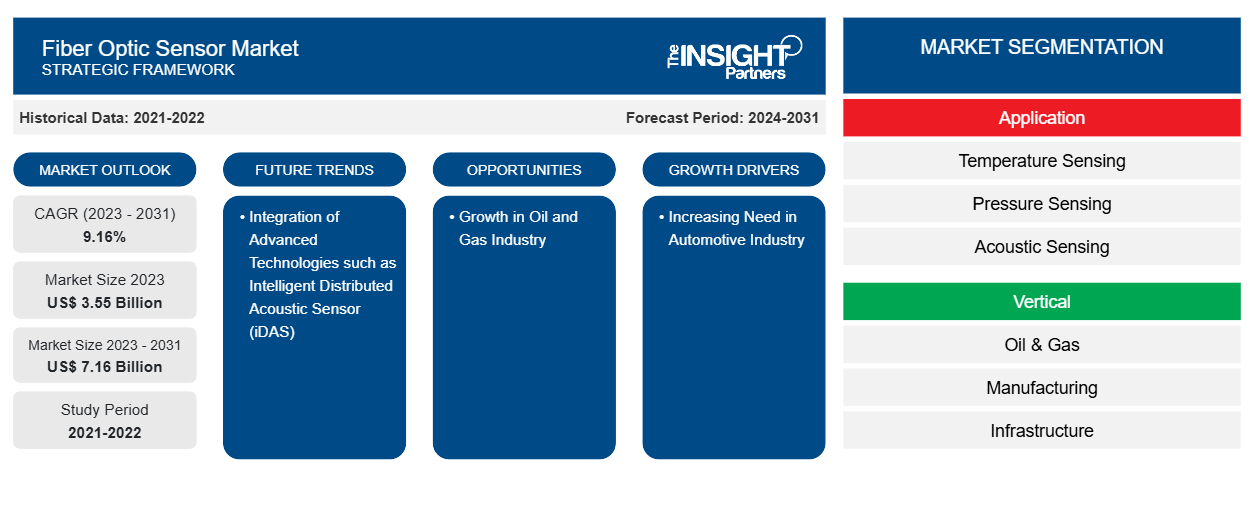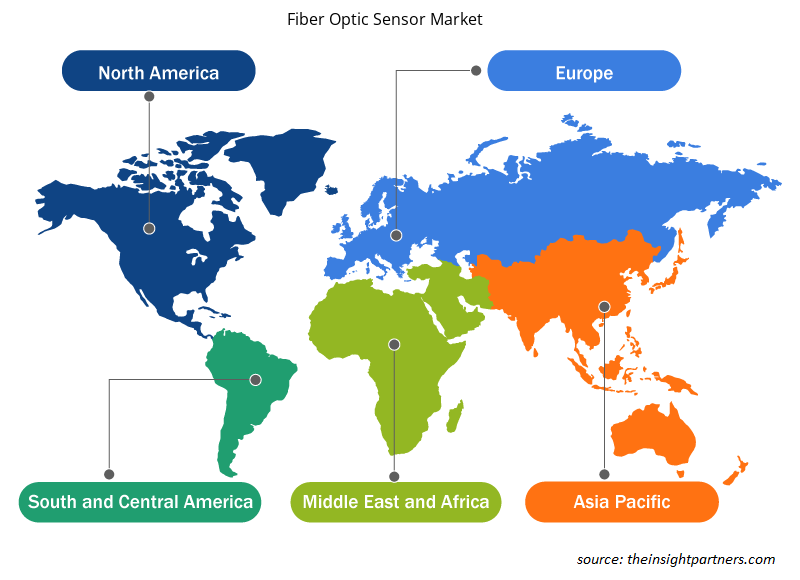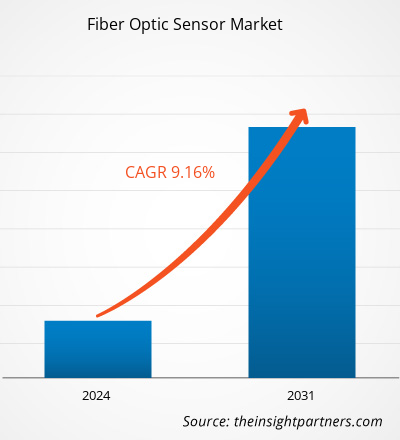Si prevede che il mercato dei sensori in fibra ottica raggiungerà i 6,76 miliardi di dollari entro il 2031, rispetto ai 3,61 miliardi di dollari del 2024. Si prevede che il mercato registrerà un CAGR del 9,7% nel periodo 2025-2031. Miniaturizzazione e portabilità introdurranno probabilmente nuove tendenze nel mercato nei prossimi anni.
Analisi di mercato dei sensori in fibra ottica
Il rilevamento in fibra ottica è una tecnologia utilizzata per misurare variazioni chimiche, sollecitazioni, temperatura, campi elettrici e magnetici, pressione, spostamento, rotazione, radiazione, livello dei liquidi, flusso, intensità luminosa e vibrazioni. Un sensore in fibra ottica è un dispositivo che utilizza la fibra ottica per rilevare variazioni nell'ambiente (chiamati sensori intrinseci) o per trasmettere segnali da un sensore remoto a un'apparecchiatura di elaborazione (chiamati sensori estrinseci). Questi minuscoli sensori sono comunemente utilizzati nel telerilevamento per diversi vantaggi. Non richiedono alimentazione elettrica nel punto di rilevamento e una singola fibra può supportare più sensori. Questi vantaggi li rendono convenienti ed efficienti per le operazioni di monitoraggio su lunghe distanze. I sensori in fibra ottica sono resistenti e possono funzionare a temperature estreme. Poiché non trasportano elettricità, funzionano bene anche in aree con elevate interferenze elettriche, alta tensione o materiali infiammabili; questo li rende ideali per l'uso in settori come il petrolio e il gas, l'edilizia, l'aerospaziale e l'assistenza sanitaria.
Panoramica del mercato dei sensori in fibra ottica
L'aumento delle applicazioni nel settore petrolifero e del gas e la crescente domanda di monitoraggio strutturale (SHM) in diversi settori sono i fattori chiave che sostengono il mercato dei sensori in fibra ottica. Questi sensori svolgono un ruolo cruciale nel migliorare la sicurezza e l'efficienza di edifici, condotte e sistemi di trasporto. Anche settori come quello petrolifero e del gas, energetico e delle telecomunicazioni stanno adottando queste tecnologie di rilevamento per migliorarne le prestazioni e l'affidabilità. Con l'evoluzione di sempre più settori verso l'automazione e sistemi più intelligenti, si prevede una crescita costante del mercato globale dei sensori in fibra ottica nei prossimi anni. Lo sviluppo delle città intelligenti e la crescita del settore delle energie rinnovabili creeranno opportunità redditizie nel mercato nel prossimo futuro.
Riceverai la personalizzazione gratuita di qualsiasi report, incluse parti di questo report, analisi a livello nazionale, pacchetto dati Excel e potrai usufruire di fantastiche offerte e sconti per start-up e università.
Mercato dei sensori in fibra ottica: approfondimenti strategici

-
Scopri le principali tendenze di mercato di questo rapporto.Questo campione GRATUITO includerà analisi di dati che spaziano dalle tendenze di mercato alle stime e alle previsioni.
Driver e opportunità di mercato dei sensori in fibra ottica
Crescente domanda di monitoraggio della salute strutturale
In tutto il mondo, l'attenzione alla sicurezza delle infrastrutture e al monitoraggio in tempo reale è in continua crescita, con conseguente aumento della domanda di sistemi avanzati di monitoraggio strutturale (SHM). Con l'espansione delle città moderne e l'invecchiamento delle infrastrutture, è sempre più necessario rilevare precocemente i segnali di danno o cedimento in strutture come ponti, gallerie, dighe ed edifici. I sistemi tradizionali, come gli estensimetri resistivi, spesso non offrono la massima durata, precisione a lungo termine e adattabilità. I sensori in fibra ottica si sono affermati come un'alternativa migliore ai sistemi di monitoraggio tradizionali, offrendo vantaggi quali design compatto, resistenza alla corrosione e tolleranza alle interferenze elettromagnetiche. Inoltre, la loro possibilità di essere integrati direttamente nelle strutture ne sta aumentando la popolarità. Queste qualità li rendono ideali per il monitoraggio strutturale (SHM) a lungo termine, anche in ambienti difficili. Questi sensori possono misurare con precisione parametri fisici chiave come deformazione, temperatura, vibrazioni e inclinazione, essenziali per il mantenimento dell'integrità e della sicurezza delle infrastrutture.
Per far fronte alla crescente domanda, le aziende del mercato dei sensori in fibra ottica stanno investendo per scalare le proprie tecnologie. Ad esempio, Sentea, spin-off di imec e fornitore di sistemi di lettura per sensori in fibra ottica, ha raccolto con successo circa 2,6 milioni di dollari USA (2,3 milioni di euro) nel 2021 per espandere la propria attività. L'annuncio di questo investimento è stato fatto nell'ottobre 2021. Sostenuta da investitori come Finindus, PMV, QBIC II e Fidimec, l'iniziativa di espansione di Sentea si concentra sullo sviluppo della tecnologia fotonica integrata per consentire il rilevamento in fibra ottica su larga scala in applicazioni di ingegneria civile, petrolifera e del gas, delle energie rinnovabili e medicali. Tali investimenti riflettono il crescente potenziale di implementazione della tecnologia di rilevamento in fibra ottica nelle applicazioni SHM, alimentando così la crescita del mercato dei sensori in fibra ottica.
Sviluppo delle città intelligenti
Il governo indiano ha lanciato la missione "100 Smart Cities" il 25 giugno 2015, con l'obiettivo di sviluppare 100 città in tutto il paese con infrastrutture moderne, un ambiente pulito e sostenibile e una migliore qualità della vita attraverso l'uso di soluzioni intelligenti. Promuove uno sviluppo urbano olistico – sociale, economico, fisico e istituzionale – nell'ambito di un programma sponsorizzato centralmente con circa 6.400 milioni di dollari (48.000 crore di rupie indiane) di finanziamenti centrali, integrati da stati e altre fonti, inclusi i partenariati pubblico-privati (PPP). La missione mira a creare modelli replicabili di crescita urbana sostenibile e inclusiva che altre città possano seguire. Nell'Unione Europea (UE), NetZeroCities sostiene la missione "100 città intelligenti e a impatto climatico zero entro il 2030" nell'ambito del programma Horizon Europe.
Con l'espansione delle città intelligenti, la necessità di strumenti di monitoraggio avanzati come i sensori in fibra ottica continuerà a crescere. Questi sensori possono fornire dati in tempo reale e funzionare bene in ambienti difficili, oltre a garantire una lunga durata. Possono essere utilizzati per monitorare ponti, strade, gallerie, edifici, condutture idriche e sistemi energetici. Ad esempio, possono rilevare crepe nei ponti, perdite nelle condutture o variazioni di temperatura nelle reti elettriche, aiutando successivamente le autorità cittadine a intervenire prima che i problemi diventino gravi. Questi sensori possono essere utilizzati anche in sistemi di traffico intelligenti, reti intelligenti ed edifici intelligenti, dove contribuiscono a migliorare le prestazioni e la sicurezza. Pertanto, l'ascesa delle città intelligenti offre un'opportunità redditizia per il mercato dei sensori in fibra ottica, poiché questi sensori contribuiscono a creare sistemi connessi ed efficienti.
Analisi della segmentazione del rapporto di mercato dei sensori in fibra ottica
I segmenti chiave che hanno contribuito alla derivazione dell'analisi di mercato dei sensori in fibra ottica sono il tipo di rilevamento, l'utente finale e l'applicazione.
- In base al tipo di rilevamento, il mercato dei sensori in fibra ottica è segmentato in rilevamento della temperatura, rilevamento della pressione, rilevamento acustico, rilevamento della deformazione e altri. Il segmento del rilevamento della temperatura deteneva la quota maggiore del mercato nel 2024.
- In base all'utente finale, il mercato dei sensori in fibra ottica è segmentato in settori quali petrolio e gas, manifatturiero, infrastrutture, aerospaziale e difesa, energia e servizi di pubblica utilità, e altri. Il segmento petrolio e gas deteneva la quota di mercato maggiore nel 2024.
- In base all'applicazione, il mercato dei sensori in fibra ottica è segmentato in monitoraggio di cavi ad alta tensione o ad alta potenza, monitoraggio di condotte , applicazioni upstream, rilevamento incendi in asset critici, applicazioni CCS/CCUS e altri. Il segmento "altri" ha detenuto la quota di mercato maggiore nel 2024.
Analisi della quota di mercato dei sensori in fibra ottica per area geografica
L'ambito geografico del rapporto sul mercato dei sensori in fibra ottica è suddiviso principalmente in cinque regioni: Nord America, Asia-Pacifico, Europa, Medio Oriente e Africa, e Sud e Centro America. L'Asia-Pacifico deteneva una quota di mercato significativa nel 2024.
Approfondimenti regionali sul mercato dei sensori in fibra ottica
Le tendenze e i fattori regionali che influenzano il mercato dei sensori in fibra ottica durante il periodo di previsione sono stati ampiamente spiegati dagli analisti di Insight Partners. Questa sezione illustra anche i segmenti e la distribuzione geografica del mercato dei sensori in fibra ottica in Nord America, Europa, Asia-Pacifico, Medio Oriente e Africa, e America meridionale e centrale.

- Ottieni i dati specifici regionali per il mercato dei sensori in fibra ottica
Ambito del rapporto di mercato sui sensori in fibra ottica
| Attributo del report | Dettagli |
|---|---|
| Dimensioni del mercato nel 2024 | 3,61 miliardi di dollari USA |
| Dimensioni del mercato entro il 2031 | 6,76 miliardi di dollari USA |
| CAGR globale (2025-2031) | 9,7% |
| Dati storici | 2021-2023 |
| Periodo di previsione | 2025-2031 |
| Segmenti coperti |
Per tipo di rilevamento
|
| Regioni e paesi coperti |
America del Nord
|
| Leader di mercato e profili aziendali chiave |
|
Densità degli operatori del mercato dei sensori in fibra ottica: comprendere il suo impatto sulle dinamiche aziendali
Il mercato dei sensori in fibra ottica è in rapida crescita, trainato dalla crescente domanda degli utenti finali, dovuta a fattori quali l'evoluzione delle preferenze dei consumatori, i progressi tecnologici e una maggiore consapevolezza dei vantaggi del prodotto. Con l'aumento della domanda, le aziende stanno ampliando la propria offerta, innovando per soddisfare le esigenze dei consumatori e sfruttando le tendenze emergenti, alimentando ulteriormente la crescita del mercato.
La densità degli operatori di mercato si riferisce alla distribuzione delle imprese che operano in un determinato mercato o settore. Indica quanti concorrenti (operatori di mercato) sono presenti in un determinato spazio di mercato in relazione alle sue dimensioni o al suo valore totale.
Le principali aziende che operano nel mercato dei sensori in fibra ottica sono:
- Baumer Holding AG
- Pepperl+Fuchs SE
- Wenglor Sensoric GmbH
- NEC Corp
- Proximion AB
- OMRON Corp
Disclaimer : le aziende elencate sopra non sono classificate secondo alcun ordine particolare.

- Ottieni una panoramica dei principali attori del mercato dei sensori in fibra ottica
Notizie di mercato e sviluppi recenti sui sensori in fibra ottica
Il mercato dei sensori in fibra ottica viene valutato raccogliendo dati qualitativi e quantitativi a seguito di ricerche primarie e secondarie, che includono importanti pubblicazioni aziendali, dati di associazioni e database. Di seguito sono elencati alcuni degli sviluppi del mercato:
Wenglor ha presentato l'amplificatore in fibra ottica P1XD, progettato specificamente per applicazioni in spazi compatti. I modelli della serie P1XD2 offrono opzioni di integrazione flessibili, consentendo all'amplificatore di funzionare in modo indipendente o come parte di un sistema in rete, in modalità master o subordinata. (Fonte: Wenglor, comunicato stampa, dicembre 2024)
Honeywell (NASDAQ: HON) e Civitanavi Systems (EURONEXT MILANO: CNS) hanno lanciato una nuova unità di misura inerziale per clienti commerciali e della difesa in tutto il mondo. La famiglia HG2800 è composta da unità di misura inerziale di livello tattico a basso rumore, elevata larghezza di banda e alte prestazioni, progettate per il puntamento, la stabilizzazione e la navigazione di breve durata su aerei commerciali e militari, tra le altre applicazioni. (Fonte: Honeywell, comunicato stampa, settembre 2023)
Copertura e risultati del rapporto di mercato sui sensori in fibra ottica
Il rapporto "Dimensioni e previsioni del mercato dei sensori in fibra ottica (2021-2031)" fornisce un'analisi dettagliata del mercato che copre le seguenti aree:
- Dimensioni e previsioni del mercato dei sensori in fibra ottica a livello globale, regionale e nazionale per tutti i principali segmenti di mercato coperti dall'ambito
- Tendenze del mercato dei sensori in fibra ottica, nonché dinamiche di mercato come driver, restrizioni e opportunità chiave
- Analisi PEST e SWOT dettagliate
- Analisi di mercato dei sensori in fibra ottica che copre le principali tendenze del mercato, il quadro globale e regionale, i principali attori, le normative e i recenti sviluppi del mercato
- Analisi del panorama industriale e della concorrenza che copre la concentrazione del mercato, l'analisi della mappa di calore, i principali attori e gli sviluppi recenti per il mercato dei sensori in fibra ottica
- Profili aziendali dettagliati
- Analisi storica (2 anni), anno base, previsione (7 anni) con CAGR
- Analisi PEST e SWOT
- Valore/volume delle dimensioni del mercato - Globale, Regionale, Nazionale
- Industria e panorama competitivo
- Set di dati Excel
Report recenti
Testimonianze
Motivo dell'acquisto
- Processo decisionale informato
- Comprensione delle dinamiche di mercato
- Analisi competitiva
- Analisi dei clienti
- Previsioni di mercato
- Mitigazione del rischio
- Pianificazione strategica
- Giustificazione degli investimenti
- Identificazione dei mercati emergenti
- Miglioramento delle strategie di marketing
- Aumento dell'efficienza operativa
- Allineamento alle tendenze normative






















 Ottieni un campione gratuito per - Mercato dei sensori in fibra ottica
Ottieni un campione gratuito per - Mercato dei sensori in fibra ottica